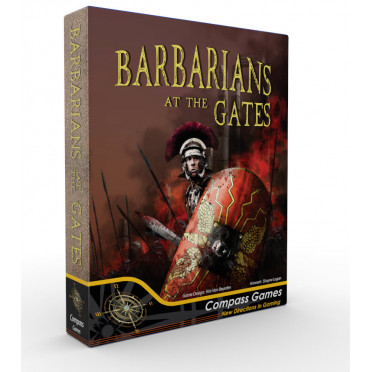The Roman player commands the Roman legions loyal to the failing central authority and the Germanic peoples who have peacefully settled within the Roman Empire, while the Barbarian player leads the usurping emperors and controls the migrations of the savage Germanic peoples, the barbarians.
The game is played on a map of the Western Roman Empire, divided into 11 dioceses (administrative districts) such as Gallia Belgica, Caledonia or Italia Suburbicaria, each composed of spaces such as Roma, Massilia or Nova Carthago. These spaces are connected to each other by the network of Roman roads, wilder connections (mainly in uncivilized territory) or river connections (mainly the Donau and the Rhine).
Players take turns playing cards to activate generals (loyalist Roman generals like Aetius, usurper emperors like Magnentius, and barbarian chieftains like Atilla or Alaric) for movements and/or sieges, to bring new barbarian invasions into play, to recruit new legions, to lead barbarian bands in raids from the frontier to the interior of Roman lands, to settle formerly hostile tribes on Roman soil, or even to succeed in usurping the imperial throne from its previous occupant!
In the course of their travels, chieftains will encounter enemy armies and fight, winning eternal glory or ending up in a forgotten grave. Barbarian tribes will probe the fortified frontier for enemy weaknesses, while outnumbered legions will have to use the interior lines (and the excellent Roman road network) to meet every threat in the unfortified Italian, Iberian and Gallic diocese.
From the time of Valentinian I and the early Vandal and Frankish migrations, to Attila and the Huns, to Theodosius I and the Gothic invasions, Barbarians at the Gates will allow players to battle over the future of Western Europe. Will there be enough Roman civilization left to spark a Renaissance, or will Europe remain forever in the Dark Ages?
The game is played on a map of the Western Roman Empire, divided into 11 dioceses (administrative districts) such as Gallia Belgica, Caledonia or Italia Suburbicaria, each composed of spaces such as Roma, Massilia or Nova Carthago. These spaces are connected to each other by the network of Roman roads, wilder connections (mainly in uncivilized territory) or river connections (mainly the Donau and the Rhine).
Players take turns playing cards to activate generals (loyalist Roman generals like Aetius, usurper emperors like Magnentius, and barbarian chieftains like Atilla or Alaric) for movements and/or sieges, to bring new barbarian invasions into play, to recruit new legions, to lead barbarian bands in raids from the frontier to the interior of Roman lands, to settle formerly hostile tribes on Roman soil, or even to succeed in usurping the imperial throne from its previous occupant!
In the course of their travels, chieftains will encounter enemy armies and fight, winning eternal glory or ending up in a forgotten grave. Barbarian tribes will probe the fortified frontier for enemy weaknesses, while outnumbered legions will have to use the interior lines (and the excellent Roman road network) to meet every threat in the unfortified Italian, Iberian and Gallic diocese.
From the time of Valentinian I and the early Vandal and Frankish migrations, to Attila and the Huns, to Theodosius I and the Gothic invasions, Barbarians at the Gates will allow players to battle over the future of Western Europe. Will there be enough Roman civilization left to spark a Renaissance, or will Europe remain forever in the Dark Ages?
| Theme(s) | War, Antiquity | |
| Language(s) | English | |
| Mechanism(s) | Wargame | |
| Author(s) | Kris Van Beurden | |
| Artist | Shayne Logan | |
| Country of origin | China | |
| Editor | Compass Games | |
| EAN | 197644597741 |
Soyez le premier à commenter ce jeu
Vous devez être identifié pour soumettre des avis.
Copyright © 2025 www.philibertnet.com Legals - Privacy Policy - Cookie Preferences - Sitemap







